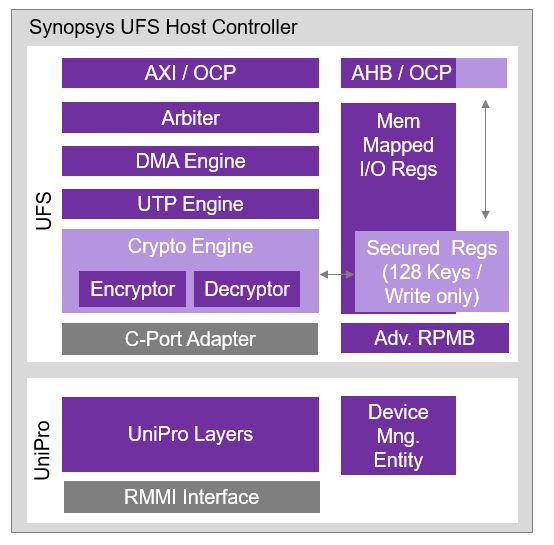Industry Expert Blogs

|
UFS 4.0 Explained: How the Latest Flash Storage Standard Propels Our 5G WorldLJ Chen, Sr. Staff Product Manager, and Dana Neustadter, Senior Product Manager for Security Solutio - Synopsys, Inc.Apr 17, 2023 |
Have you ever really stopped to think about how truly amazing your smartphone is? From our handheld devices, we can plan dinner out with friends, hail a ride to the restaurant, watch videos or play online games while en route, and capture and share photos from the meal. A host of technologies goes into making these activities possible. In this blog post, we'll shine the spotlight on Universal Flash Storage (UFS) 4.0, the latest version of the standard that is considered the flash storage for our 5G era.
UFS is a JEDEC-defined standard for flash storage. It delivers higher data transfer speeds, lower power, and increased reliability compared to the legacy embedded multimedia card (eMMC) flash storage standard. Thanks to the UFS standard, we can store vacations worth of high-resolution photos on our phones or call up large video files from our tablets with a few taps.
The performance advantage of UFS is enabled, in part, by its ability to perform simultaneous reads and writes due to its full-duplex interface. By contrast, eMMC is only able to read and write as separate, asynchronous tasks due to its legacy parallel or half-duplex interface. UFS also enables two lanes of data transfer for devices using UFS 2.0 and beyond. The result is that while eMMC data transfer speeds may achieve 400MBps, the UFS 4.0 specification enables data transfer rates up to 5800 MBps. With this type of performance, UFS is becoming the preferred storage option in the 5G mobile world.
When JEDEC announced the UFS 4.0 specification in 2022, the 5G world gained speeds of up to 2900 MBps per lane, double the rate of the preceding UFS 3.1 solution. In this world, fast and secure connectivity and storage are important. Specific to security, data encryption and Replay Protected Memory Block (RPMB) are included in UFS devices as a means to protect data confidentiality and prevent replay attacks through eavesdropping.
Designing for the latest standard does come with some challenges. Read on to learn how you can optimize your implementation of UFS 4.0-based designs with proven IP.
What Is UFS 4.0?
UFS 4.0 uses the MIPI M-PHY Gear5 high-speed interface as the physical layer (PHY) to connect memory components in a device, while MIPI UniPro provides the transport and link layers to interconnect chipsets and peripheral components. The payload length in UFS 4.0 is up to 1144 bytes thanks to UniPro 2.0, which lowers protocol overhead while improving throughput and delivering higher link speed. Compared to UFS 3.1, UFS 4.0 provides a 46% power savings while maintaining backwards compatibility with UFS 3.1. It can support up to 1TB of storage in a compact form factor.
Because consumers now store personal and sensitive information on their mobile devices, robust security is an important consideration. UFS 4.0 uses Advanced Replay Protected Memory Block (RPMB) and inline memory encryption to keep passwords, account information, and other data safe from malicious attacks. Encrypted data is stored securely, accessible only via authentication.
How Does UFS 4.0 Enhance Mobile Devices?
Let's take a look at how some key applications for UFS 4.0 benefit from the standard:
- Smartphones and tablets can tap into high-speed reads and writes for large data files, which translates into faster recording of high-frame-rate videos and faster load times for online games. Low power and security advantages are beneficial as well, in preserving battery life and protecting user data, respectively.
- Automotive applications can also take advantage of fast data transfer speeds, for video as well as for diagnostic applications to support functional safety requirements. Reliability and security are important here, too.
- Augmented reality (AR) and virtual reality (VR) benefit from the high speeds as well as low latency and low power for more seamless, longer lasting immersive experiences.
- Smart TVs benefit from high-speed reads/writes for video and gaming, as well as the capacity to store operating system and application data.
What's Needed to Address the Key Challenges of UFS 4.0-Based Chip Designs?
With its doubled data rate and payload length increase compared to its predecessor, UFS 4.0 requires a new controller and boasts a more complex design with a higher gate count. Expertise backed by comprehensive knowledge of the latest standard are needed to design and verify a compliant, efficient solution.
This is where proven, robust IP can help streamline the design and verification processes while minimizing integration risks. An established leader inUFS Host Controller IP , Synopsys is first to market with UFS 4.0 IP. Synopsys Host Controller IP for UFS 4.0 supports the faster throughput and higher capacity of the latest specification. Delivering high performance and low power, the host controller IP was designed with robust security features:
- Inline encryption (IE) provides encrypt/decrypt hardware acceleration to secure data written to the UFS device, with low latency to minimize impact on read/write performance.
- IE leverages standards-compliant Advanced Encryption Standard-XES Tweakable Block Ciphertext Stealing (AES-XTS) cryptographic algorithm with 128-bit and 256-bit key sizes for high-grade security level.
- Management of up to 128 separate hardware keys allows for fine granular encryption capabilities.
- Keys are writable only through secure ports and cannot be read by software for maximum security.
- Advanced RPBM provides a protected memory block for sensitive user or transaction data, as well as support of media access control (MAC) authentication to prevent replay attacks through eavesdropping

Synopsys has been a key contributor to the JEDEC specification and continues to provide the industry's first verification solutions including Synopsys Verification IP and Test suites for UFS. Synopsys Verification IP for UFS provides a comprehensive set of protocol, methodology, verification, and productivity features, enabling users to achieve rapid verification of UFS links operating in high speed and low speed modes.
